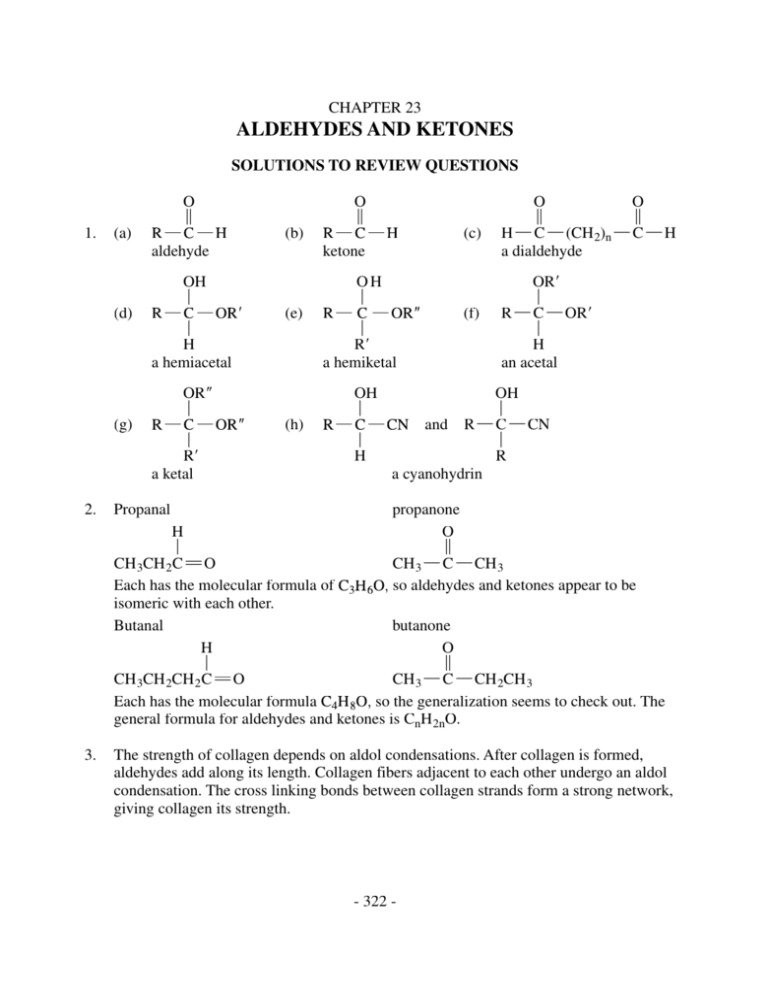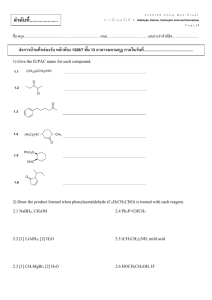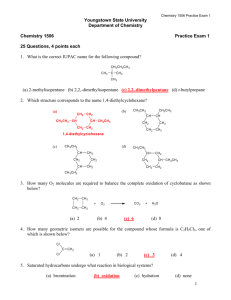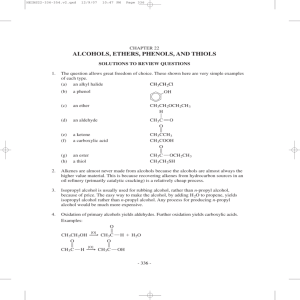aldehydes and ketones - faculty at Chemeketa
advertisement

CHAPTER 23 ALDEHYDES AND KETONES SOLUTIONS TO REVIEW QUESTIONS 1. O ‘ (a) (b) aldehyde (d) (g) 2. OH ƒ ƒ H a hemiacetal OR– ƒ ƒ R¿ a ketal Propanal O ‘ (c) ketone ¿ – (e) (h) OH ƒ ƒ R¿ a hemiketal OH ƒ ƒ H – (f) O O ‘ ‘ H ¬ C ¬ (CH 2)n ¬ C ¬ H a dialdehyde OR¿ ƒ R ¬ C ¬ OR ¿ ƒ H an acetal OH ƒ and R ¬ C ¬ CN ƒ R a cyanohydrin propanone O ‘ CH 3 ¬ C ¬ CH 3 so aldehydes and ketones appear to be H ƒ CH 3CH 2C “ O Each has the molecular formula of isomeric with each other. Butanal butanone H O ƒ ‘ CH 3CH 2CH 2C “ O CH 3 ¬ C ¬ CH 2CH 3 Each has the molecular formula so the generalization seems to check out. The general formula for aldehydes and ketones is CnH 2nO. 3. The strength of collagen depends on aldol condensations. After collagen is formed, aldehydes add along its length. Collagen fibers adjacent to each other undergo an aldol condensation. The cross linking bonds between collagen strands form a strong network, giving collagen its strength. - 322 - - Chapter 23 - 4. 1-Butanol has a boiling point of 118°C while the boiling point for butanal is 76°C and for butanone, 80°C. Of these three compounds, only 1-butanol can hydrogen bond to itself. This additional bonding holds the molecules together more tightly and accounts for the much higher boiling point. 5. The versatile aldol condensation reaction allows Streptomyces to synthesize a wide variety of different antibiotics. 6. Acetaldehyde carries a reactive aldehyde functional group that can bond to many different biochemicals: by reacting with amino acids, acetaldehyde slows protein synthesis; by reacting with antioxidants, acetaldehyde increases oxidative damage to the liver; by reacting with specific proteins, acetaldehyde hampers the liver’s ability to export needed chemicals to the blood stream. Acetaldehyde can cause liver cirrhosis. 7. A ketone is a carbonyl functional group that is bonded to two alkyl or aryl groups. Cortisone is a ketone-containing hormone. The sugar, fructose, contains a ketone. Ketones are also found in Vitamin K1. 8. (a) (b) 9. When an aldehyde reacts with Benedict solution, the blue color of copper ion disappears and a red-brown precipitate forms. When an aldehyde reacts with Tollens solution, the silver ion in solution forms a thin silver metal mirror on the inside of the glass container used in the test. The phenol-formaldehyde polymer is rigid because covalent bonds not only form the polymers but also cross-link the polymers to each other. 10. MEK is an abbreviation for methyl ethyl ketone. Its main use is as a solvent, especially for lacquers and paints. 11. A ketone group, ≈ C O , cannot be located at the end of a carbon-carbon chain. √ Consequently its only possible location in both propanone and butanone is on C-2 of these ketones. Therefore its location need not be numbered. - 323 - - Chapter 23 - SOLUTIONS TO EXERCISES 1. Names of aldehydes. (a) CH 3 O ƒ ‘ (b) O O ‘ ‘ (c) 2 2 (d) (e) 2. O ‘ CH “ CHC ¬ H O ‘ C ¬H CH 3 ≈ √ C“C ≈ √ H H Names of aldehydes O ‘ (a) O ‘ (b) (c) O ‘ C¬H Cl (d) O ‘ C¬H methanal, formaldehyde 3-methylbutanal butanedial 3-phenylpropenal cis-2-butenal ethanal, acetaldehyde butanal, butyraldehyde benzaldehyde 2-chloro-5-isopropylbenzaldehyde CH3CHCH3 - 324 - - Chapter 23 - O ‘ (e) 3-hydroxybutanal ƒ OH 3. Names of ketones (a) propanone, acetone, dimethyl ketone (b) 1-phenyl-l-propanone, ethyl phenyl ketone (c) cyclopentanone (d) 4-hydroxy-4-methyl-2-pentanone 4. Names of ketones (a) butanone, methyl ethyl ketone (MEK) (b) 3,3-dimethylbutanone, t-butyl methyl ketone (c) 2,5-hexanedione (d) 1-phenyl-2-propanone, benzyl methyl ketone 5. Structural formulas (a) ‘ O (b) (c) (d) (e) 1,3-dichloropropanone O ‘ 2 3-butenal 2 O ‘ CH3CH2CCHCH2CH3 O ‘ 3 2 2 O ‘ ƒ CH 2CH 3 2 2 4-phenyl-3-hexanone hexanal 3-ethyl-2-pentanone - 325 - - Chapter 23 - 6. Structural formulas O ‘ (a) O ‘ (b) ƒ CH 3 (c) (d) (e) 7. (a) (b) (c) 8. (a) (b) (c) 9. 3-hydroxypropanal 4-methyl-3-hexanone O cyclohexanone O ‘ ƒ Cl ƒ Cl ƒ Cl O ‘ 2,4,6-trichloroheptanal 3-pentenal Acetaldehyde is a common name. The IUPAC name is ethanal. 2-Methyl-3-butanone is numbered incorrectly. The correct IUPAC name is 3-methyl-2-butanone. 1-Hexanal is incorrect because the aldehyde needs no number. The correct IUPAC name is hexanal. 2-Methyl-3-propanal is numbered incorrectly and the aldehyde needs no number. The correct IUPAC name is 2-methylpropanal. Formaldehyde is a common name. The IUPAC name is methanal. 4-Hexanone is numbered incorrectly. The correct IUPAC name is 3-hexanone. Boiling points depend on molecular size (larger molecules have higher boiling points) and intermolecular bonding (molecules that hydrogen bond have higher boiling points than molecules that don’t hydrogen bond; polar molecules have higher boiling points than non-polar molecules). (a) Although 3-pentanone and 2-pentanol are about the same size, 2-pentanol can hydrogen bond to itself. 2-Pentanol has the higher boiling point. (b) Ethanal is both larger and more polar than ethane. Ethanal has the higher boiling point. (c) 1,3-Propanediol is larger and hydrogen bonds to itself while propanone is smaller and can’t hydrogen bond to itself. 1,3-Propanediol has the higher boiling point. - 326 - - Chapter 23 - (d) Pentanal is both larger and more polar than propane. Pentanal has the higher boiling point. 10. Boiling points depend on molecular size (larger molecules have a higher boiling points) and intermolecular bonding (molecules that hydrogen bond have higher boiling points than molecules that don’t hydrogen bond; polar molecules have higher boiling points than non-polar molecules). (a) Butanone is both larger and more polar than butane. Butanone has the higher boiling point. (b) Although 2-butanol and butanone are about the same size, 2-butanol can hydrogen bond to itself while butanone can’t. 2-Butanol has the higher boiling point. (c) 2-Pentanone is both larger and more polar than propane. 2-Pentanone has the higher boiling point. (d) 1,2-Propanediol is larger and can hydrogen bond to itself while propanal is smaller and can’t hydrogen bond to itself. 1,2-Propanediol has the higher boiling point. 11. Aqueous solubility depends on the size of the alkyl chain (the smaller alkyl chain has more aqueous solubility) and bonding between the solute and water (hydrogen bonding solutes have higher aqueous solubilities; more polar solutes have higher aqueous solubilities). (a) Both 2-heptanone and propanone are ketones but propanone has a much smaller alkyl chain. Propanone has a higher aqueous solubility. (b) Pentane and pentanal have the same sized alkyl chains but pentanal can hydrogen bond to water. Pentanal has the higher water solubility. (c) 3-Pentanone and 2,4-pentanedione have the same sized alkyl chains but 2,4-pentanedione has two ketone functional groups while 3-pentanone has only one. 2,4-Pentanedione can hydrogen bond more strongly to water and has the higher aqueous solubility. 12. Aqueous solubility depends on the size of the alkyl chain (the smaller alkyl chain has more aqueous solubility) and bonding between the solute and water (hydrogen bonding solutes have higher aqueous solubilities; more polar solutes have higher aqueous solubilities). (a) 3-Hydroxypentanal has a smaller alkyl chain and two functional groups that can hydrogen bond to water while 3-hexanone has a larger alkyl chain and only one functional group that can hydrogen bond to water. 3-Hydroxypentanal has the higher aqueous solubility. (b) Cyclohexanone and cyclohexane have the same sized alkyl chains but cyclohexanone can hydrogen bond to water. Cyclohexanone has the higher aqueous solubility. - 327 - - Chapter 23 - (c) 13. Propanone and 2-pentanone are both ketones but propanone has the smaller alkyl chain. Propanone has the higher aqueous solubility. Equations for the oxidation of: (a) 3-pentanol OH O ƒ ‘ K2Cr2O7 : CH 3CH 2CHCH 2CH 3 9H99 H H CC C C H 2CH 3 2 3 SO 2 (b) same product for air 3-methyl-l-hexanol 4 oxidation O ‘ Cu CH 3CH 2CH 2CHCH 2CH 2OH + O2 ¢ " CH 3CH 2CH 2CHCH 2C ¬ H ƒ ƒ CH 3 CH 3 O ‘ K2Cr2O7 CH 3CH 2CH 2CHCH 2CH 2OH 9H99 : CH CH CH C HC C H 3 2 2 2 ¬H 2SO4 ƒ ƒ CH 3 CH 3 K2Cr2O7 CH 3CH 2CH 2CHCH 2COOH 999 H2SO4: ƒ CH 3 14. Equations for the oxidation of: (a) 1-propanol O ‘ K2Cr2O7 CH 3CH 2CH 2OH 9H99 C H 2C H 2 C ¬ H SO : 2 CH 3CH 2CH 2OH + O2 (b) OH ƒ ƒ ƒ CH 3 CH 3 4 or CH 3CH 2COOH O ‘ Cu " C H 2C H 2 C ¬ H ¢ Ag ¢ No reaction (3° alcohol) with either oxidizing agent - 328 - - Chapter 23 - 15. (a) O ‘ CH 3 ¬ C H 2 ¬ C ¬ O H O (b) OC CH3 CH CH3 O (c) OC CH3 CH CH3 16. O ‘ – C ¬ O– (a) O (b) 17. O C O CH2CH 2 C O (c) O ‘ CH 3 ¬ CH 2 ¬ CH 2 ¬ C ¬ OH (a) propanal, (b) (c) O ‘ CH 3 ¬ CH 2 ¬ CH butanone, O ‘ CH 3 ¬ C ¬ CH 2 ¬ CH 3 butanal, O ‘ CH 3 ¬ C H 2 ¬ C H 2 ¬ C H - 329 - - Chapter 23 - 18. (a) (b) (c) 19. (a) (b) (c) 20. (a) (b) (c) 21. (a) O ‘ formaldehyde (methanal) CH 2 O ‘ propanal, CH 3 ¬ CH 2 ¬ CH O ‘ propanal, CH 3 ¬ CH 2 ¬ CH H ƒ An aldehyde group, , must be present to give a positive Tollens test. The visible evidence for a positive Tollens test is the formation of a silver mirror on the inner walls of a test tube. H ƒ + NH3 CH 3C “ O + 2 Ag + 99: CH 3COO -NH4 + 2 Ag(s) H2O H ƒ An aldehyde group, , must be present to give a positive Fehling test. The visible evidence for a positive Fehling test is the formation of brick red Cu2O, which precipitates during the reaction. H ƒ 2+ 3 NaOH 3 H2O The aldehyde is oxidized in the Tollens test: – + CH3CH2COO NH4 (b) The ketone is reduced: OH CH3CHCH2CH2CH2CH3 (c) (silver mirror) The aldehyde is oxidized in the Benedict test: CH 3 CH 3 CH + COO Na - 330 - 2 (brick-red) - Chapter 23 - (d) The aldehyde is reduced: CH3CH2CH2CH2CH2CH2CH2OH 22. (a) The aldehyde is reduced: CH3 CH3CH2CHCH2OH (b) The aldehyde is oxidized in the Benedict test: O CH 3 CO (c) Na The ketone is reduced: OH CH3CHCH3 (d) The aldehyde is oxidized in the Tollens test: O CH 3 CH 2 CH CO NH4 CH 2 CH 3 23. HCN adds to a carbonyl functional group to form a cyanohydrin. In turn, the cyanohydrin can be reacted with water to make an α-hydroxy acid. OH (a) CH 3 C COOH CH 3 OH (b) CH 3CH 2CH 2 CH COOH OH (c) CH 3CH 2CH CH 3 C COOH CH 3 - 331 - - Chapter 23 - 24. HCN adds to a carbonyl functional group to form a cyanohydrin. In turn, the cyanohydrin can be reacted with water to make an α-hydroxy acid. (a) HOCH2COOH OH (b) CH3 CH2 CH2 CH2 C CH3 COOH CH3 OH (c) CH3 C CH COOH CH3 25. Aldol condensation (a) butanal O ‘ CH CH C 3 2 2 ¬H (b) 2 O ‘ ¬ CH2C ¬ H OH O ƒ ‘ dilute " CH 3CH 2CH 2CHCH C ¬ H NaOH ƒ CH 2CH 3 OH O ƒ ‘ ¬ CH2CH ¬ CHC ¬ H dilute NaOH phenylethanal 26. Aldol condensation O ‘ (a) 2 CH 3CH 2CCH 2CH 3 3-pentanone (b) H ƒ 2 CH 3CH 2C “ O propanal CH 2CH 3 ƒ dilute " CH C C H 3 2 ¬ C H ¬ C C H 2C H 3 NaOH ƒ ƒ ‘ HO CH 3 O CH 3 ƒ dilute " CH CH C H C HC “ O 2 3 NaOH ƒ ƒ OH H - 332 - - Chapter 23 - 27. The completed equations are: O CH 3 OCH 2 ‘ dryHCl ≈ √ (a) CH 3CCH 3 + CH 2CH 2 ERF C √ ≈ ƒ ƒ CH 3 OCH 2 OH OH H ƒ H+ (b) CH 3CH 2C “ O + CH 3CH 2OH ERF CH 3CH 2 ƒƒ (c) 28. H 2O OH ƒ C ¬ OCH 2CH 3 ƒ H O ‘ H2O CH 3CHCH 2CH(OCH 3)2 999 : CH 3CHCH 2C ¬ H + 2 CH 3OH H+ ƒ ƒ OH OH The completed equations are: H OCH 2CH 2CH 3 ƒ ƒ dryHCl (a) CH 3CH 2C “ O + 2 CH 3CH 2CH 2OH ERF CH 3CH 2C ¬ OCH 2CH 2CH 3 + H 2O ƒ H O (b) (c) 29. + ± OH H+ CH3OH Δ CH 3CH 2CH 2(OCH 3)2 OCH3 H ƒ H2O C C C C H H H 999 : 3 2 2 “ O + 2 CH 3OH + H Sequence of reactions: (a) (b) CH 3 ƒ CH 3CCH 3 + HCN ¡ CH 3C ¬ CN ‘ ƒ O OH CH 3 CH 3 ƒ ƒ CH 3C ¬ CN + H 2O ¡ CH 3C ¬ COOH ƒ ƒ OH OH - 333 - - Chapter 23 - (c) 30. 31. 32. CH 3 ƒ O ¬ C ¬ COOH CH 3 O ƒ ƒ ‘ CH 3 dryHCl " CH 3CH 2 CH 3C ¬ COOH + CH 3C ¬ H ƒ CH 3 OH ƒ O ¬ C ¬ COOH ƒ CH 3 ƒƒ ƒƒ Sequence of reactions: (a) H ƒ OH– ¬ C “ O ± HCN ¡ OH ƒ ¬ CH ¬ CN (b) OH ƒ H± ¬ CH ¬ CN ± H2O ¡ OH ƒ ¬ CHCOOH (c) OH ƒ ¬ CHCOOH K2Cr2O7 H2SO4 H ƒ H+ HOCH 2CH 2CH 2C “ O 99: O ‘ C 3C O ‘ ¬ C ¬ COOH O H OH ethanal - 334 - - Chapter 23 - 33. Four aldol condensation products from a mixture of ethanal (E) and propanal (P) are possible. EE PP EP PE O CH 3 ‘ ƒ EE is C 3C C 2C PP is CH 3CH 2CHCHC ¬ H ƒ ƒ ‘ OH O OH CH 3 O ƒ ‘ EP is C 3C C C PE is CH 3CH 2CHCH 2C ¬ H ƒ ‘ ƒ OH OH O 34. A hemiacetal forms when an alcohol adds to a carbonyl group. OH OH HC HC CHOH CHOH O CH OH O CH OH C HOH HC H2C CH2OH five-membered cyclic hemiacetal 35. (a) (b) H ƒ six-membered cyclic hemiacetal O ‘ and 3 3. The Tollens test (silver mirror) or Fehling test (red ) will give positive results with propanal but not with acetone. H H ƒ ƒ and CH 2 “ CHC “ O 3 2 Bromine will decolorize immediately with the second compound (propenal) but not with propanal. 3 2 - 335 - - Chapter 23 - (c) 36. 37. ¬ CH2CH2OH ¬ CHCH3 ƒ OH Oxidize both compounds: 2-phenylethanol will give 2-phenylethanal and 1-phenylethanol will give methyl phenyl ketone. 1-phenylethanal will give a positive Tollens or Benedict test and methyl phenyl ketone will not give a positive test. and H H ƒ ƒ H2O CH 3C “ O + HCN ¡ CH 3C ¬ CN 999 : CH 3CH ¬ COOH H+ ƒ ƒ OH OH lactic acid OH ƒ ¬ CHC ‚ N H+ ¡ O ‘ ¬C¬H ± HCN benzaldehyde 38. Pyruvic acid is changed to lactic acid by a reduction reaction. 39. The alcohols which should be oxidized to give these ketones. (a) 3-pentanone: 3-pentanol CH 3CH 2CHCH 2CH 3 ƒ OH CH 3CHCH 2CH 3 (b) methyl ethyl ketone: 2-butanol ƒ OH ¬ CH2CH2CHCH3 (c) 4-phenyl-2-butanone: 4-phenyl-2-butanol ƒ OH - 336 - - Chapter 23 - 40. O O CH3 CH2 CH2 CH2 CH CH3 CH2 CH2 CCH 3 CH3 CH CH2 CH CH3 CH2 CCH 2 CH3 O O CH3 O CH3 CH2 CH CH O CH3 CCHCH3 CH3 CH3 CH 3 O CH 3 C CH CH 3 41. Ketones will not react in the Fehling test. The following are all the ketones with the formula, C6H12O: O O O CH3 CH2 CH2 CH2 CCH3 CH3 CH2 CH2 CCH 3 CH 3 O CH3 CCH2 CH CH3 CH3 42. (a) (b) (c) CH3 O CH 3 C C CH 3 CH3 CH2 CCH CH3 CH3 O CH 3 CH3 CCHCH2 CH3 CH3 1. This step is an aldol condensation that occurs in dilute NaOH. 2. This step oxidizes the aldehyde to a carboxylic acid. Common oxidizing conditions are set by the Tollens test (Ag+, NH3, H2O) or the Fehling/Benedict test (Cu2+, NaOH, H2O). 1. This step forms a cyanohydrin and the conditions require hydroxide (OH–). 2. This step reacts the cyanohydrin with water to form an α-hydroxy acid. Conditions require acid (H+) as well as water. 1. This step is an aldol condensation that occurs in dilute NaOH. 2. This step reduces the aldehyde to form a primary alcohol. Common reducing conditions involve heat (Δ), hydrogen gas, and a nickel catalyst. - 337 - - Chapter 23 - 43. 44. 45. H ƒ b CH 3C “ O ¬a CH 2CH ¬ CH 2CH ¬ CH 2CH ¬ CH 2CH ¬ n ƒ ƒ ƒ ƒ OH OH OH OH In phenol, three positions, ortho, ortho, and para to the OH group are used in the reaction to form a thermosetting polymer. However, in p-cresol the para position is occupied by a methyl group and cannot react with formaldehyde. This leaves the p-cresol molecule as a bifunctional monomer, resulting in a linear, thermoplastic polymer. (a) O ‘ ƒ OH 2,3-dihydroxypropanal ƒ OH O ‘ CH 2C ¬ CH 2 ƒ ƒ OH OH (b) 1,3-dihydroxypropanone OH ƒ 2 ƒ ƒ OH OH ƒ H O ‘ ƒ OH ƒ OH 2 and - 338 - OH OH OH O ƒ ‘ ƒ ƒ CH 2 C ¬ C ¬ CH ƒ ƒ HO ¬ CH 2 CH 2OH









